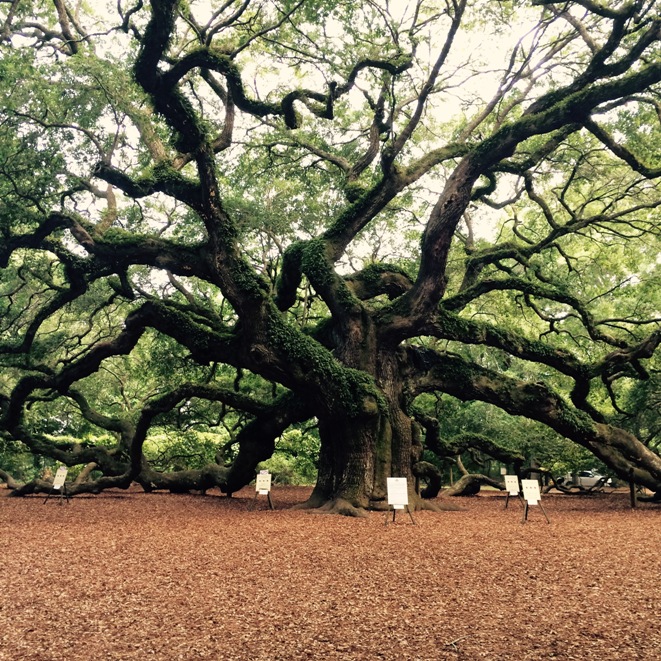
You are safe.
Confederate flags, alongside American flags, flap in the wind. White children play in their front yards while their fathers look on.
Everything is fine.
I notice a sign on my left, indicating that two and a half miles north was a historic plantation, with slave cabins available for tour.
Intact. Restored.
The traffic signal ahead turns red, and I ease my car to a stop. To my right, a large truck pulls up. Windows rolled down. A hand casually dangling a cigarette out of the window. I gaze upward and meet the glare of four white men. I face forward in time for the traffic signal to turn green again. The truck to my right screeches forward, as they speed away. I take a deep sigh of relief.
You are safe.
Using my phone, I follow the directions to my next destination, as a creeping sensation of anxiety begins to flow through me, but I stick to my plan. Undeterred by this overcoming sense of fear and dread. After driving for a while longer, I reach the church, and park.
Everything is fine.
I repeat this over and over to myself as I walk down a cobbled street. I felt my legs continue to move me forward as my stomach fluttered and my heart began to race.
You are safe. Everything is fine. You are safe. Everything is fine.
Just two days prior, a young white man entered a black church and killed nine people during a bible study meeting.
I remember hearing this on the news and my heart swelled with sadness. This tragedy came at a time where my mind felt like it was still reeling from anger and anguish as I contemplated the murders and racist-fueled abuse of black people across the country. I remembered those nine lives taken and despite my anxiety, I pushed myself forward.
Determined to see the church. I had to see the church.
I rounded the corner and felt a rush of adrenaline as I found myself in the mix of news vans and reporters. A line of black people, faces lined with sweat, stood behind barricades. Church fans in hand trying to combat the blistering heat of Charleston, South Carolina.
I wove my way through white women handing out bottles of water and individuals taking pictures of the stuffed animals and candles placed outside as a memorial to the lives lost.
Police officers stood around the church, with waists heavy from their guns and tasers. I felt the air become increasingly heavy as my breath quickened. My eyes welled with tears. Despite the chaos around me, I started to cry. I wiped my eyes and stood up to head back to my car then quickly realized I was too shaken to walk and my breathing was shallow and rapid. I sat back down and pulled my knees to my chest, with the sudden realization that if I didn’t attempt to calm myself down now, I would fall into a panic attack.
A couple of days later, I returned back home and began to notice how my experiences in Charleston, along with the emotions that seemed to reach a distressing peak by my visit, were beginning to influence my world-view and my interactions with others.
While reading through material for class, I came across the term Secondary Trauma, which is used to refer to the distress an individual can experience when hearing about the first-hand trauma of another. The symptoms of secondary trauma have shown up in people of color—specifically black people—as heightened fear and hyper-vigilance, headaches, insomnia, body aches, memory difficulty, self-blame, confusion, shame and guilt.
In order to begin a process of healing from race-based secondary trauma, it has been helpful for me to do the following:
Acknowledge It.
There is no“right” way to react to racism and racism fueled acts of violence towards black communities.
It was important for me to be aware and accept what I was thinking and feeling, while also just noticing the ways my body responded to distress. There are a few things I found helpful to do to increase self-awareness and one of them is journaling—whether it be a lengthy time of writing or a quick notation of the feelings that were coming up for me.
Practicing mindful body scans to check for signs of stress and anxiety can also be helpful in the act of acknowledging when an interaction, event or space is triggering a particular emotional reaction. Doing these things can serve to increase the ability to identify the range of emotions and physical reactions we may be experiencing, all of which should not be minimized.
Discuss It and Seek Support.
At times, it can be helpful to openly discuss our experiences following racially traumatizing situations.
By talking to those we trust, an open discourse is created that can help to prevent the tendency to minimize the individual experience. Minimizing can lead to an internalization of negative racial experiences, which contributes to feelings of anger, sadness, or anxiety. Speaking to others who may have similar reactions can feel normalizing and validating.
However, it is important to note that not everyone may serve as a source of support. Not all people of color, including those who identify as black, will understand issues of racism and discrimination in the same that you do.
Care for Myself.
Self-care includes any intentional actions that are taken to care for our physical, mental, and/or emotional health. As I’ve been exploring ways to begin a journey of healing and healthier coping from race-based secondary trauma, I’ve discovered how self-care is a necessity in getting me through day-to-day nuanced activities.
Self-care is unique for everyone and can include small things like waking up on time to eat breakfast at home every morning or stretching before going to bed at night. Internal coping strategies such as mindfulness practices, meditation, reading, or indigenous healing systems and faith practices can serve to promote mental and emotional well-being.
Empower through Resistance.
Experiencing acts of racism, whether direct or secondary, can lead to feelings of helplessness and hopelessness. In order to combat these feelings, for many it is important to engage and participate in activities that are actively seeking to promote change.
Channeling hurt, anger and feelings of hopelessness and/or helplessness into social-change activities within the community can lead to feelings of empowerment.
Be gentle with yourself and forgiving of your humanness.
“Caring for myself is not self-indulgence. It is self-preservation and that is an act of political warfare.”
~ Audre Lorde.
Relephant:
Eyes Wide Open: A Buddhist Teacher’s Perspective on Race & Social Change. {Podcast}
Author: Alandria Mustafa
Editor: Khara-Jade Warren
Photo: Author’s Own






Read 0 comments and reply